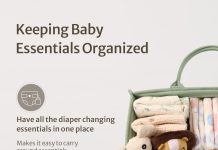Looking to find a purpose for your old crib that is now just taking up space? Whether you want to give it away to someone in need or make a little extra cash by selling it, figuring out the best way to donate or sell a used crib can sometimes be a challenge. Luckily, we’ve got you covered. In this article, we’ll explore some practical tips and options to help you navigate the process seamlessly, ensuring that your crib finds a new home where it can continue to bring joy and comfort.
Review contents
1. Donating a Used Crib
Donating a used crib is a wonderful way to give back to the community and help families in need. Before donating, it’s important to do some research and follow a few steps to ensure the crib is safe and in good condition for its new recipient.
1.1 Research Local Charities and Organizations
The first step in donating a used crib is to research local charities and organizations that accept crib donations. Look for organizations that specifically focus on helping families in need or those that support children’s welfare. You can check with your local churches, shelters, or community centers to find these organizations. Reach out to them and inquire about their donation policies and if they are currently accepting crib donations.
1.2 Check Safety Standards and Guidelines
Before donating a crib, it’s crucial to check safety standards and guidelines to ensure the crib meets all necessary requirements and is safe for use. Familiarize yourself with the Consumer Product Safety Commission (CPSC) guidelines and recommendations for cribs. Inspect the crib for any loose or broken parts, sharp edges, or potential hazards. Make any necessary repairs to bring the crib up to standard.
1.3 Clean and Prepare the Crib
Clean the crib thoroughly before donating to ensure it is in its best condition. Use a mild detergent and warm water to wipe down all surfaces, including the mattress support and railings. Remove any stickers or tape, and make sure there are no stains or odors. If the crib has multiple parts, disassemble it for easier transportation.
1.4 Contact Potential Recipients
Once you’ve identified local charities or organizations, reach out to them to discuss your donation. Provide them with information about the crib, including its brand, model, and overall condition. Ask about their specific requirements and if there are any restrictions on the type of crib they can accept. It’s essential to ensure that your crib meets their specific criteria before proceeding with the donation.
1.5 Arrange for Pickup or Drop-off
Once you’ve confirmed the donation with the organization, arrange for pickup or drop-off of the crib. Some organizations may offer a pick-up service, while others may require you to drop off the crib at their location. Ensure you have a clear understanding of the logistics and schedule a suitable time for the donation. Double-check any paperwork or documentation required by the organization and make sure to keep copies for your records.
2. Selling a Used Crib
If you prefer to sell your used crib instead of donating it, there are several steps to take to ensure a successful sale. By following these guidelines, you can find a buyer who will appreciate and value your crib.
2.1 Assess the Condition of the Crib
Before selling a used crib, carefully assess its overall condition. Look for any wear and tear, such as scratches or dents, and check for missing or damaged components. Ensure that all parts, including screws and bolts, are present and in good working condition. This evaluation will help you determine a fair price for your crib.
2.2 Determine a Reasonable Price
To determine a reasonable price for your used crib, consider its age, condition, and any additional features it may have. Research the current market value of similar cribs to get an idea of what others are selling for. Keep in mind that you may need to be flexible with pricing, especially if you’re looking for a quick sale. Price your crib competitively, but don’t undervalue it.
2.3 Choose a Selling Platform
Selecting the right selling platform is crucial when selling a used crib. Consider online marketplaces such as eBay, Craigslist, or Facebook Marketplace, as they attract a wide range of potential buyers. You can also explore local classified ads or parenting forums. Each platform has its own set of rules and guidelines, so familiarize yourself with them before listing your crib for sale.
2.4 Create an Informative Listing
When creating a listing for your crib, be sure to provide detailed and accurate information. Include the crib’s brand, model, dimensions, and any notable features. Mention the crib’s condition, highlighting any wear and tear or cosmetic flaws. Be transparent and provide clear, high-quality photos that showcase the crib from different angles. A well-written and informative listing will attract potential buyers.
2.5 Arrange for Payment and Delivery
Once you find a buyer for your used crib, it’s essential to establish a secure method of payment and plan for delivery. Consider using reputable payment platforms like PayPal or Venmo, which offer buyer and seller protection. Agree upon a suitable method of delivery, whether it’s shipping the crib or meeting the buyer in person. Take into account the buyer’s location and your own convenience when deciding on the delivery method.
3. Safety Considerations
Whether you’re donating or selling a used crib, safety should always be a top priority. Follow these safety considerations to ensure the well-being of the crib’s future users.
3.1 Check for Recalls
Before donating or selling a used crib, check if the crib has been subject to any recalls. Visit the CPSC website or the manufacturer’s website to search for any safety recalls related to the crib’s brand and model. If there is a recall, follow the manufacturer’s instructions to address the issue or contact them directly for guidance.
3.2 Provide Accurate Product Information
When donating or selling a crib, provide accurate and detailed product information to potential recipients or buyers. Include the crib’s brand, model, and manufacturing date if available. Mention any safety certifications or compliance with safety standards. Being transparent and providing complete information builds trust and ensures the crib’s safety is known.
3.3 Include Clear Photos
When creating a listing or presenting the crib to potential recipients, include clear and high-quality photos. Showcase the crib from different angles and provide close-ups of any notable features or potential wear and tear. Clear photos help buyers or recipients evaluate the crib’s condition and identify any potential safety concerns.
3.4 Offer Disassembly Instructions
If the crib needs to be disassembled for transportation or storage, provide clear and detailed disassembly instructions. Include labeled diagrams or step-by-step instructions to guide the recipient or buyer throughout the process. Ensuring proper disassembly reduces the risk of damage during transport and makes reassembly easier.
3.5 Communicate Safety Guidelines
When donating or selling a used crib, communicate essential safety guidelines to the recipient or buyer. Provide information on proper mattress fit, safe sleeping practices, and any specific guidelines recommended by the manufacturer. Educating the new users on crib safety contributes to a safe and healthy sleeping environment for their child.
4. Donating or Selling to Families in Need
Donating or selling a used crib to families in need can make a significant difference in their lives. Here are some strategies to connect with families who could benefit from your generosity:
4.1 Reach out to Local Parenting Groups
Connect with local parenting groups or associations in your community to find families in need of a crib. These groups often have resources or networks dedicated to supporting families who require assistance. Reach out to them and inquire about any families who may benefit from your donated or sold crib.
4.2 Utilize Online Parenting Forums
Online parenting forums and communities can be a valuable resource to find families in need. Join discussion boards or forums specific to parenting and inquire about families who may be looking for a crib. Be respectful and mindful of community guidelines when posting your offer.
4.3 Contact Social Service Organizations
Social service organizations can often facilitate the distribution of donated or sold items to families in need. Research local organizations that focus on assisting low-income families, single parents, or those experiencing financial difficulties. Contact them to discuss your donation or sale and inquire about their process for connecting with families in need.
4.4 Donate or Sell at a Reduced Price
If selling the crib, consider offering it at a reduced price to families who may have limited financial resources. This can make the crib more affordable for families in need while still allowing you to recoup some of your expenses. Alternatively, you can choose to donate the crib without any payment to a family who truly cannot afford to purchase one.
4.5 Consider Sharing Free of Charge
In situations where families are facing extreme financial hardship, consider sharing your used crib free of charge. This act of kindness can provide crucial support to families who may not have the means to obtain a crib otherwise. Reach out to local charities or social service organizations that specialize in assisting families in dire circumstances.
5. Ensuring Compliance with Regulations
When donating or selling a used crib, it’s important to ensure compliance with safety regulations and legal requirements. Follow these steps to remain within the bounds of the law.
5.1 Research Legal Requirements
Before donating or selling a used crib, research any legal requirements or regulations that apply in your area. Check if there are any restrictions on selling certain types of cribs or if additional safety standards must be met. Being aware of these regulations will help you navigate the process smoothly and avoid any legal issues.
5.2 Follow Consumer Product Safety Commission (CPSC) Guidelines
The CPSC provides comprehensive guidelines for crib safety and is an important reference when donating or selling a used crib. Familiarize yourself with these guidelines and ensure that your crib meets all the necessary safety standards. By adhering to the CPSC’s recommendations, you help guarantee the well-being of the crib’s future users.
5.3 Verify Safety Standards of International Buyers
If selling a used crib to an international buyer, it’s important to verify the safety standards and regulations of their country. Different countries may have varying safety requirements for cribs, and it’s essential to ensure that your crib complies with those standards. Research the safety guidelines specific to the buyer’s country or consult with experts to ensure compliance.
5.4 Keep Records of Donations or Sales
Maintain accurate records of any crib donations or sales, including relevant documentation, receipts, and communication with recipients or buyers. These records serve as proof of your compliance with regulations and can be valuable in case of any future inquiries or audits.
5.5 Seek Legal Advice if Unsure
If you have any doubts or concerns about the legal aspects of donating or selling your used crib, it’s advisable to seek legal advice. An attorney specializing in product safety or consumer law can provide guidance on compliance and help ensure that you are meeting all necessary requirements.
6. Recycling Options
If your used crib is no longer suitable for donation or sale, consider exploring recycling options. Choose one of these alternatives to reduce waste and give your crib a new purpose.
6.1 Find Local Recycling Centers
Research local recycling centers that accept cribs for recycling. These centers specialize in dismantling and processing various materials, including wood, metal, and plastic, to minimize waste. Contact them to inquire about their specific requirements for crib recycling.
6.2 Check with Municipal Waste Management
Check with your municipal waste management services to see if they offer crib recycling programs. Some municipalities have dedicated initiatives or partnerships that allow residents to recycle larger items like cribs. They can provide guidance on how to prepare the crib for recycling and the appropriate collection methods.
6.3 Explore Furniture Recycling Programs
Some organizations or companies specialize in repurposing or recycling furniture items, including cribs. Research furniture recycling programs in your area that may accept cribs. These programs can often transform used cribs into new pieces or repurpose the materials for other projects.
6.4 Repurpose or Upcycle the Crib
If you have the creativity and skills, consider repurposing or upcycling the crib yourself. Transform it into a new piece of furniture, such as a bench, bookshelf, or desk. There are numerous online resources and tutorials available to guide you through the process. Repurposing the crib not only reduces waste but also gives it a new life.
6.5 Donate Parts for DIY Projects
If you’re unable to repurpose the entire crib, consider donating the crib’s parts for various DIY projects. The crib’s frame, rails, or mattress support can be valuable resources for crafters, artists, or DIY enthusiasts. Advertise these parts on local classified ads or online platforms dedicated to DIY projects.
7. Communicating Condition and History
When donating or selling a used crib, clear and transparent communication about its condition and history is crucial. Follow these guidelines to ensure potential buyers or recipients are well-informed.
7.1 Be Transparent about Wear and Tear
Honesty is key when describing the crib’s condition. Be transparent about any wear and tear, scratches, or cosmetic flaws. Clearly highlight any areas that may need minor repairs or touch-ups. This transparency helps manage expectations and avoids any misunderstandings.
7.2 Report Any Past Incidents or Damage
If the crib has been involved in any past incidents, such as falls or accidents, it’s essential to report them to potential buyers or recipients. Provide an accurate account of any incidents and specify whether repairs were made. This information allows them to properly assess the crib’s safety and decide if it’s suitable for their needs.
7.3 Disclose Previous Repairs or Modifications
If the crib has undergone any repairs or modifications, disclose these to potential buyers or recipients. Clearly communicate the nature of the repairs or modifications and the expertise involved. This disclosure ensures they are aware of the crib’s history and can make an informed decision.
7.4 Describe Storage and Usage Conditions
When describing the crib, provide information about its previous storage and usage conditions. Mention if the crib was kept in a smoke-free or pet-free environment. Any relevant details about where and how the crib was used can give potential buyers or recipients a better understanding of its overall condition.
7.5 Answer Potential Buyers’ Questions Honestly
Be prepared to answer any questions potential buyers or recipients may have regarding the crib. Respond honestly and provide accurate information to the best of your knowledge. Prompt and transparent communication helps build trust and confidence in the product you are offering.
8. Packaging and Transport
Ensuring the safe packaging and transport of a used crib is essential to maintain its condition and prevent damage. Follow these steps to properly prepare the crib for transportation.
8.1 Disassemble the Crib Properly
If the crib needs to be disassembled for packaging and transport, ensure you do so properly. Refer to the manufacturer’s instructions or any additional disassembly guidelines you may have. Keep all the components organized and labeled for easy reassembly.
8.2 Clean and Sanitize Components
Before packaging the crib, clean and sanitize all components for hygiene purposes. Wipe down all surfaces, including the mattress support, railings, and hardware. Use a mild detergent and warm water for cleaning. Allow the components to dry completely to prevent any mold or mildew growth during transportation.
8.3 Securely Pack all Parts
To protect the crib during transportation, securely pack all its parts. Use appropriate packaging materials such as bubble wrap, packing paper, or foam inserts to cushion and protect delicate components. Place any small parts or hardware in labeled bags and securely attach them to the main components to ensure they are not lost.
8.4 Label and Document for Safety
Label all packages clearly to indicate their contents and the crib brand and model. Document any specific handling instructions or precautions to ensure the safe transport of the crib. This information helps both the transporter and the recipient handle the crib with care.
8.5 Choose an Appropriate Transport Method
When selecting a transport method, consider the size and weight of the crib, as well as the transport requirements of the recipient or buyer. Depending on the distance and location, options may include local pickup, courier services, or freight shipping. Choose a method that ensures the crib arrives at its destination safely and undamaged.
9. Reputation and Trust
Maintaining a positive reputation and building trust is crucial when donating or selling a used crib. Follow these guidelines to establish credibility and foster a favorable reputation.
9.1 Maintain Good Communication
Consistent and open communication is essential throughout the donating or selling process. Respond promptly to inquiries, provide updates, and address any concerns or questions raised by potential recipients or buyers. Good communication builds trust and establishes a positive rapport.
9.2 Provide Prompt Responses
When potential recipients or buyers reach out to you, strive to provide prompt responses. Timely communication shows professionalism and a willingness to assist. Being responsive to inquiries and requests helps establish trust and confidence in your credibility.
9.3 Follow through with Commitments
Ensure that you follow through with any commitments or arrangements you make. If you promise to provide additional information or arrange for pickup or delivery, be sure to fulfill your commitments in a timely manner. Keeping your word demonstrates reliability and reliability strengthens trust.
9.4 Encourage Reviews and Testimonials
After completing a donation or sale, encourage recipients or buyers to leave reviews or testimonials about their experience. Positive reviews can serve as a testament to your credibility and the quality of the crib you donated or sold. Reviews and testimonials build trust for other potential recipients or buyers in the future.
9.5 Build a Positive Reputation
Consistently providing excellent service, being honest in your representations of the crib, and meeting or exceeding expectations can help build a positive reputation. Positive word-of-mouth and recommendations from satisfied recipients or buyers contribute to establishing yourself as a trustworthy source for used cribs.
10. Protecting Buyers and Sellers
When engaging in the process of buying or selling a used crib, it’s crucial to protect both parties involved. Follow these guidelines to ensure a safe and secure transaction.
10.1 Use Secure Payment Methods
When selling a crib, use secure payment methods that offer buyer and seller protection. Platforms like PayPal or Venmo provide safeguards against fraudulent activities and offer dispute resolution mechanisms in case of any issues. Avoid accepting cash or other payment methods that provide minimal protection.
10.2 Confirm Buyer’s Identity and Intentions
Before finalizing a sale, confirm the buyer’s identity and intentions. Obtain the necessary contact information, such as their full name, address, and phone number. If possible, request identification verification to ensure the buyer’s credibility. This precautionary measure minimizes the risk of fraudulent activities.
10.3 Meet in Safe Public Locations
If opting for an in-person exchange, arrange to meet the buyer in a safe public location. Choose a well-populated area with surveillance cameras, such as a shopping mall or police station. Avoid secluded or unfamiliar locations to ensure your personal safety during the transaction.
10.4 Create a Bill of Sale
When selling a used crib, create a bill of sale that includes all pertinent details of the transaction. Include the buyer’s and seller’s names, contact information, crib details, the sale price, and the date of the transaction. Both the buyer and the seller should sign and keep a copy of the bill of sale for their records.
10.5 Be Wary of Scams and Fraudulent Activities
Be cautious of potential scams or fraudulent activities when buying or selling a used crib. Look out for red flags such as unrealistic offers, requests for unusual payment methods, or overly aggressive buyers. Trust your instincts and be willing to walk away from a transaction if it raises any concerns.






























